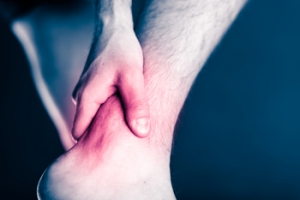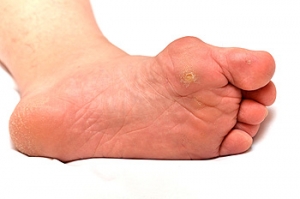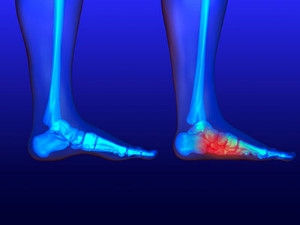Connect With Us
Featured Articles
Super User
Causes of Achilles Tendon Injuries
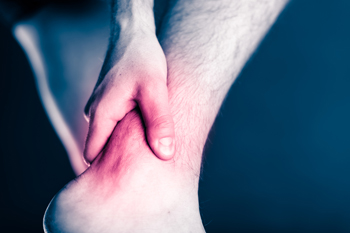 People who experience Achilles tendon injuries are typically involved in jumping and running activities. Additionally, this type of injury may occur as a result of suddenly tripping or falling from an extreme height. The function of the Achilles tendon is to connect the calf muscles to the heel area. If this should become torn, there typically are noticeable signs that an Achilles tendon rupture has occurred. These may include hearing a loud and popping noise, followed by severe pain and discomfort. A confirmation is typically needed to determine if an Achilles tendon injury has occurred, and this may be accomplished by having and MRI or ultrasound performed. If you have endured this type of injury, it is suggested that you seek the advice of a podiatrist who can determine what the best course of treatment is for you.
People who experience Achilles tendon injuries are typically involved in jumping and running activities. Additionally, this type of injury may occur as a result of suddenly tripping or falling from an extreme height. The function of the Achilles tendon is to connect the calf muscles to the heel area. If this should become torn, there typically are noticeable signs that an Achilles tendon rupture has occurred. These may include hearing a loud and popping noise, followed by severe pain and discomfort. A confirmation is typically needed to determine if an Achilles tendon injury has occurred, and this may be accomplished by having and MRI or ultrasound performed. If you have endured this type of injury, it is suggested that you seek the advice of a podiatrist who can determine what the best course of treatment is for you.
Achilles tendon injuries need immediate attention to avoid future complications. If you have any concerns, contact Dr. Howard Horowitz of Bowie Foot & Ankle . Our doctor can provide the care you need to keep you pain-free and on your feet.
What Is the Achilles Tendon?
The Achilles tendon is a tendon that connects the lower leg muscles and calf to the heel of the foot. It is the strongest tendon in the human body and is essential for making movement possible. Because this tendon is such an integral part of the body, any injuries to it can create immense difficulties and should immediately be presented to a doctor.
What Are the Symptoms of an Achilles Tendon Injury?
There are various types of injuries that can affect the Achilles tendon. The two most common injuries are Achilles tendinitis and ruptures of the tendon.
Achilles Tendinitis Symptoms
- Inflammation
- Dull to severe pain
- Increased blood flow to the tendon
- Thickening of the tendon
Rupture Symptoms
- Extreme pain and swelling in the foot
- Total immobility
Treatment and Prevention
Achilles tendon injuries are diagnosed by a thorough physical evaluation, which can include an MRI. Treatment involves rest, physical therapy, and in some cases, surgery. However, various preventative measures can be taken to avoid these injuries, such as:
- Thorough stretching of the tendon before and after exercise
- Strengthening exercises like calf raises, squats, leg curls, leg extensions, leg raises, lunges, and leg presses
If you have any questions please feel free to contact our office located in Bowie, MD. We offer the newest diagnostic tools and technology to treat your foot and ankle needs.
Read more about Achilles Tendon InjuriesAchilles Tendon Injuries
The Achilles tendon is the largest tendon in the body; it is a tough band of fibrous tissue that stretches from the bones of the heel to the calf muscles. This tendon is what allows us to stand on our toes while running, walking, or jumping, it is common for this tendon to become injured. In severe cases, the Achilles tendon may become partially torn or completely ruptured. However, this tendon is susceptible to injury because of its limited blood supply and the high tensions it endures.
The people who are more likely to suffer from Achilles tendon injuries are athletes who partake in activities that require them to speed up, slow down, or pivot. Consequently, athletes who engage in running, gymnastics, dance, football, baseball, basketball, or tennis are more likely to suffer from Achilles tendon injuries. Additionally, there are other factors that may make you more prone to this injury. People who wear high heels, have flat feet, have tight leg muscles or tendons, or take medicines called glucocorticoids are more likely to have Achilles tendon injuries.
A common symptom of an Achilles tendon injury is pain above the heel that is felt when you stand on your toes. However, if the tendon is ruptured, the pain will be severe, and the area may become swollen and stiff. Other symptoms may be reduced strength in the lower ankle or leg area, and reduced range of motion in the ankle. When the Achilles tendon tears, there is usually a popping sound that occurs along with it. People who have acute tears or ruptures may find walking and standing to be difficult.
If you suspect you have injured your Achilles tendon, you should see your podiatrist to have a physical examination. Your podiatrist will likely conduct a series of tests to diagnose your injury including a “calf-squeeze” test. Calf squeeze tests are performed by first squeezing the calf muscle on the healthy leg. This will pull on the tendon and consequently cause the foot to move. Afterward, the same test will be performed on the injured leg. If the tendon is torn, the foot won’t move because the calf muscle won’t be connected to the foot.
Foot Pain and Running
 People who indulge in the sport of running may often notice mild to severe foot pain, which may develop as a result of the impact the feet endure as they land on the ground. Different levels of pain may accompany specific foot conditions, which may include plantar fasciitis. This condition may develop gradually and can affect the ability to run if not treated properly and promptly. Additionally, an ailment that is known as metatarsalgia may be typically characterized by pain felt near the arch of the foot, and walking may be painful after completing a long run. If you enjoy running and are experiencing any type of foot pain, it is suggested to consult with a podiatrist who can properly diagnosis and treat any foot pain that may be present.
People who indulge in the sport of running may often notice mild to severe foot pain, which may develop as a result of the impact the feet endure as they land on the ground. Different levels of pain may accompany specific foot conditions, which may include plantar fasciitis. This condition may develop gradually and can affect the ability to run if not treated properly and promptly. Additionally, an ailment that is known as metatarsalgia may be typically characterized by pain felt near the arch of the foot, and walking may be painful after completing a long run. If you enjoy running and are experiencing any type of foot pain, it is suggested to consult with a podiatrist who can properly diagnosis and treat any foot pain that may be present.
Foot Pain
Foot pain can be extremely painful and debilitating. If you have a foot pain, consult with Dr. Howard Horowitz from Bowie Foot & Ankle . Our doctor will assess your condition and provide you with quality foot and ankle treatment.
Causes
Foot pain is a very broad condition that could be caused by one or more ailments. The most common include:
- Bunions
- Hammertoes
- Plantar Fasciitis
- Bone Spurs
- Corns
- Tarsal Tunnel Syndrome
- Ingrown Toenails
- Arthritis (such as Gout, Rheumatoid, and Osteoarthritis)
- Flat Feet
- Injury (from stress fractures, broken toe, foot, ankle, Achilles tendon ruptures, and sprains)
- And more
Diagnosis
To figure out the cause of foot pain, podiatrists utilize several different methods. This can range from simple visual inspections and sensation tests to X-rays and MRI scans. Prior medical history, family medical history, and any recent physical traumatic events will all be taken into consideration for a proper diagnosis.
Treatment
Treatment depends upon the cause of the foot pain. Whether it is resting, staying off the foot, or having surgery; podiatrists have a number of treatment options available for foot pain.
If you have any questions, please feel free to contact our office located in Bowie, MD. We offer the newest diagnostic and treatment technologies for all your foot care needs.
Read more about Foot PainFoot Pain
The feet, being the foundation of the body, carry all of the body’s weight and are therefore prone to experiencing pain and discomfort. If you are experiencing foot pain, it is important to determine where in the foot you are experiencing this pain to help discover the cause of it. While pain can be experienced virtually anywhere in the foot, the most common sites of foot pain are in the heel and ankle.
Heel pain can be due to a multitude of conditions including plantar fasciitis, Achilles tendinitis, and heel spurs. Pain experienced in the ankle can be a sign of an ankle sprain, arthritis, gout, ankle instability, ankle fracture, or nerve compression. In more serious cases, pain in the foot can be a sign of improper alignment or an infection.
Foot pain can be accompanied by symptoms including redness, swelling, stiffness and warmth in the affected area. Whether the pain can be described as sharp or dull depends on the foot condition behind it. It is important to visit your local podiatrist if your foot pain and its accompanying symptoms persist and do not improve over time.
Depending on the location and condition of your foot pain, your podiatrist may prescribe certain treatments. These treatments can include but are not limited to prescription or over-the-counter drugs and medications, certain therapies, cortisone injections, or surgery.
If you are experiencing persistent foot pain, it is important to consult with your foot and ankle doctor to determine the cause and location. He or she will then prescribe the best treatment for you. While milder cases of foot pain may respond well to rest and at-home treatments, more serious cases may take some time to fully recover.
Reminder: When Was the Last Time...?
Bunions May Lead to Additional Foot Conditions
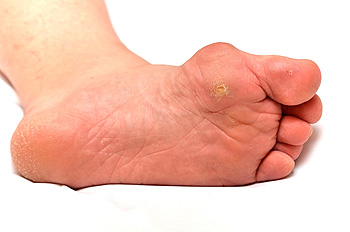 A bunion is described as a bony protrusion that forms on the side of the big toe. It may be unsightly and uncomfortable and is generally considered to be a deformity. Research has shown that specific bone structure, which may cause bunions to develop, may be inherited, in addition to having ailments that may include flat feet. Additionally, obesity and pregnancy may play a significant role in the formation of bunions, and this may be a result of the added weight the feet must endure. If you choose to wear shoes that do not have adequate room for the toes to move about in, a bunion may develop, which may lead to other foot conditions such as corns and calluses. If you notice a bump on the side of your big toe, it is suggested to seek the counsel of a podiatrist, so a proper diagnosis can be performed.
A bunion is described as a bony protrusion that forms on the side of the big toe. It may be unsightly and uncomfortable and is generally considered to be a deformity. Research has shown that specific bone structure, which may cause bunions to develop, may be inherited, in addition to having ailments that may include flat feet. Additionally, obesity and pregnancy may play a significant role in the formation of bunions, and this may be a result of the added weight the feet must endure. If you choose to wear shoes that do not have adequate room for the toes to move about in, a bunion may develop, which may lead to other foot conditions such as corns and calluses. If you notice a bump on the side of your big toe, it is suggested to seek the counsel of a podiatrist, so a proper diagnosis can be performed.
If you are suffering from bunion pain, contact Dr. Howard Horowitz of Bowie Foot & Ankle . Our doctor can provide the care you need to keep you pain-free and on your feet.
What Is a Bunion?
Bunions are painful bony bumps that usually develop on the inside of the foot at the joint of the big toe. As the deformity increases over time, it may become painful to walk and wear shoes. Women are more likely to exacerbate existing bunions since they often wear tight, narrow shoes that shift their toes together. Bunion pain can be relieved by wearing wider shoes with enough room for the toes.
Causes
- Genetics – some people inherit feet that are more prone to bunion development
- Inflammatory Conditions - rheumatoid arthritis and polio may cause bunion development
Symptoms
- Redness and inflammation
- Pain and tenderness
- Callus or corns on the bump
- Restricted motion in the big toe
In order to diagnose your bunion, your podiatrist may ask about your medical history, symptoms, and general health. Your doctor might also order an x-ray to take a closer look at your feet. Nonsurgical treatment options include orthotics, padding, icing, changes in footwear, and medication. If nonsurgical treatments don’t alleviate your bunion pain, surgery may be necessary.
If you have any questions, please feel free to contact our office located in Bowie, MD. We offer the newest diagnostic and treatment technologies for all your foot care needs.
Read more about BunionsBunions
A bunion is a bump that forms at the base of the big toe. Bunions form when the big toe pushes against the next toe, which forces the big toe joint to get bigger and stick out. As a result, the skin over the bunion may start to appear red and it may feel sore.
There are risk factors that can increase your chances of developing bunions. People who wear high heels or ill-fitting shoes are more likely to develop them, in addition to those who have a genetic history of bunions or have rheumatoid arthritis.
The most obvious way to tell if you have a bunion is to look for the big toe pushing up against the toe next to it. Bunions produce a large protrusion at the base of the big toe and may or may not cause pain. Other symptoms are redness, swelling, and restricted movement of the big toe if you have arthritis.
Nonsurgical methods are frequently used to treat bunions that aren’t severe. Some methods of nonsurgical treatment are orthotics, icing and resting the foot, taping the foot, and pain medication. Surgery is usually only required in extreme cases. However, if surgery is needed, some procedures may involve removing the swollen tissue from around the big toe joint, straightening the big toe by removing part of the bone, or joining the bones of your affected joint permanently.
Your podiatrist will diagnose your bunion by doing a thorough examination of your foot. He or she may also conduct an x-ray to determine the cause of the bunion and its severity.
Most Babies Are Born with Flat Feet
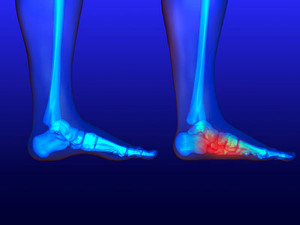 The foot condition that is referred to as flat feet simply indicates the feet are flatter on the bottom, which enables the foot to fully touch the ground while standing. Research has shown that most babies are born with flat feet, and the arch will generally develop as the aging process occurs. There may be several reasons why adults may develop flat feet, and these may include injuries that the feet may endure, wear and tear that may happen as a result of age, or possibly from a genetic trait. There may be additional factors that may contribute to flat feet, including medical ailments such as diabetes and obesity. Patients who experience this condition may notice pain in the heel or arch area of the feet, swelling in the ankle and surrounding area, or increased foot pain as activities are pursued. If you are born with or have developed flat feet, it is advised to seek the counsel of a podiatrist who can discuss proper treatment options with you.
The foot condition that is referred to as flat feet simply indicates the feet are flatter on the bottom, which enables the foot to fully touch the ground while standing. Research has shown that most babies are born with flat feet, and the arch will generally develop as the aging process occurs. There may be several reasons why adults may develop flat feet, and these may include injuries that the feet may endure, wear and tear that may happen as a result of age, or possibly from a genetic trait. There may be additional factors that may contribute to flat feet, including medical ailments such as diabetes and obesity. Patients who experience this condition may notice pain in the heel or arch area of the feet, swelling in the ankle and surrounding area, or increased foot pain as activities are pursued. If you are born with or have developed flat feet, it is advised to seek the counsel of a podiatrist who can discuss proper treatment options with you.
Flatfoot is a condition many people suffer from. If you have flat feet, contact Dr. Howard Horowitz from Bowie Foot & Ankle . Our doctor will treat your foot and ankle needs.
What Are Flat Feet?
Flatfoot is a condition in which the arch of the foot is depressed and the sole of the foot is almost completely in contact with the ground. About 20-30% of the population generally has flat feet because their arches never formed during growth.
Conditions & Problems:
Having flat feet makes it difficult to run or walk because of the stress placed on the ankles.
Alignment – The general alignment of your legs can be disrupted, because the ankles move inward which can cause major discomfort.
Knees – If you have complications with your knees, flat feet can be a contributor to arthritis in that area.
Symptoms
- Pain around the heel or arch area
- Trouble standing on the tip toe
- Swelling around the inside of the ankle
- Flat look to one or both feet
- Having your shoes feel uneven when worn
Treatment
If you are experiencing pain and stress on the foot you may weaken the posterior tibial tendon, which runs around the inside of the ankle.
If you have any questions please feel free to contact our office located in Bowie, MD. We offer the newest diagnostic and treatment technologies for all your foot and ankle needs.
Read more about Flat FeetFlat Feet
Flatfoot is a condition that occurs when the arches on the foot are flattened, which allows the soles of the feet to touch the floor. Flatfoot is a common condition and it is usually painless.
Throughout childhood, most people begin to develop arches in their feet, however, some do not. Those who do not develop arches are left with flatfoot. The pain associated with flat feet is usually at its worse when engaging in activity. Another symptom that may occur with those who have this condition is swelling along the inside of the ankle.
It is also possible to have flexible flatfoot. Flexible flatfoot occurs when the arch is visible while sitting or standing on the tiptoes, but it disappears when standing. People who have flexible flatfoot are often children and most outgrow it without any problems.
There are some risk factors that may make you more likely to develop flatfoot. Those who have diabetes and rheumatoid arthritis have an increased risk of flatfoot development. Other factors include aging and obesity.
Diagnosis for flat feet is usually done by a series of tests by your podiatrist. Your podiatrist will typically try an x-ray, CT scan, ultrasound, or MRI on the feet. Treatment is usually not necessary for flat foot unless it causes pain. However, therapy is often used for those who experience pain in their flat feet. Some other suggested treatment options are arch supports, stretching exercises, and supportive shoes.


